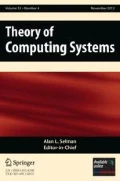Abstract
The problem of finding periodic solutions of the matrix Riccati equations of linear control theory is interpreted geometrically as a problem of finding periodic orbits of certain one-parameter transformation groups on Grassmann manifolds. For certain control problems the vector fields which generate these groups can be written as a sum of two commuting vector fields, one a gradient vector field, the other a Killing vector field, i.e., an infinitesimal isometry of a metric on the Grassman manifold. For such vector fields, the methods of Morse theory can be adapted to study the periodic orbits. The topological data that is needed to count periodic orbits, i.e., the Poincare polynomial of certain submanifolds of the Grassmann manifold, can be derived from results proved by A. Borel.
Similar content being viewed by others
References
R. Hermann,Differential Geometry and the Calculus of Variations, Interdisciplinary Mathematics, Vol. 17 (2d ed.). Math. Sci. Press, Brookline, Massachusetts.
R. Abraham and J. F. Marsden,Foundations of Mechanics (2d ed.) Benjamin/Cummings Publishing Co., Reading, MA, 1978.
J. C. Willems. Least squares stationary optimal control and the algebraic Riccati equation.IEEE Trans. Auto. Control AC-16, 621–634 (1971).
S. Smale. Morse inequalities for a dynamical system,Bull. AMS 66, 43–49 (1960).
R. Hermann. Geometric aspects of potential theory in symmetric spaces, I–III.Math. Ann. 148, 349–366. (1962); 151, 384–395 (1964).
R. Hermann. Compactification of homogeneous spaces, I–II.J. Math. Mech. 14, 655–678 (1965); 15, 667–681 (1966).
R. Hermann. Compactification of homogeneous spaces and contractions of Lie Groups.Proc. Nat'l Acad. Sci. 51, 456–461 (1964).
S. Kobayashi. Fixed points of isometries,Nagoya Math. J. 13, 63–68 (1958).
J. Milnor.Morse Theory. Princeton University Press, 1963.
R. Hermann.Lie Groups for Physicists. W. A. Benjamin, Reading, Massachusetts, 1966.
S. Helgason.Differential Geometry and Symmetric Spaces, Academic Press, 1961.
A. Borel. Sur la cohomologie des espaces filtres principaux et des espaces homogenes des groupes de Lie compacts.Annals of Math. 57, 115–176 (1953).
Author information
Authors and Affiliations
Additional information
Research supported by the Ames Research Center (NASA), #NSG-2402, U.S. Army Research Office, #ILIG1102RHN7-05 MATH and the National Science Foundation, NASA 2384-DA 62–82, DOE CONTRACT NO. DE-AC01-8 OR A-5256.
Rights and permissions
About this article
Cite this article
Hermann, R., Martin, C. Lie and morse theory for periodic orbits of vector fields and matrix riccati equations, I: General lie-theoretic methods. Math. Systems Theory 15, 277–284 (1981). https://doi.org/10.1007/BF01786984
Received:
Revised:
Issue Date:
DOI: https://doi.org/10.1007/BF01786984



